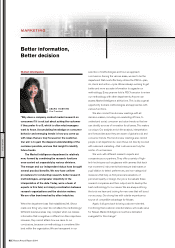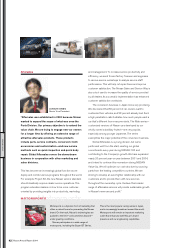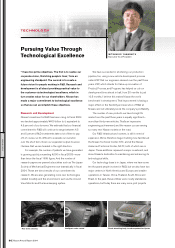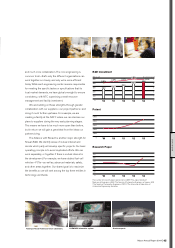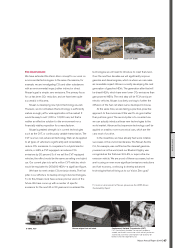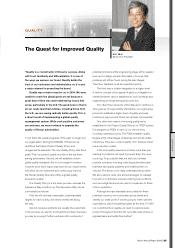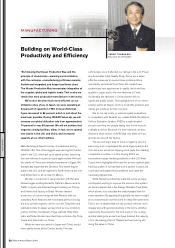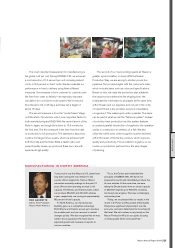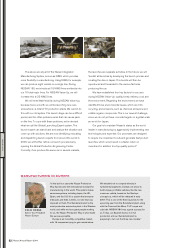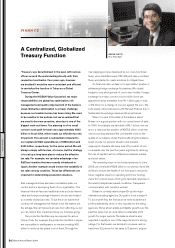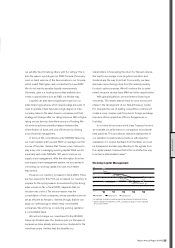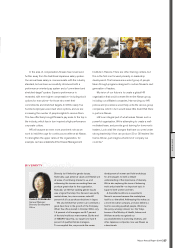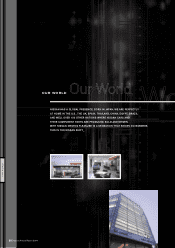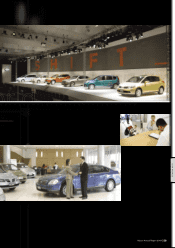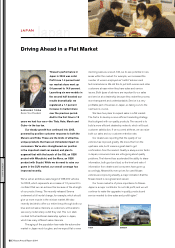Nissan 2005 Annual Report Download - page 52
Download and view the complete annual report
Please find page 52 of the 2005 Nissan annual report below. You can navigate through the pages in the report by either clicking on the pages listed below, or by using the keyword search tool below to find specific information within the annual report.
Nissan Annual Report 2004
50
Building on World-Class
Productivity and Efficiency TADAO TAKAHASHI
Executive Vice President
MANUFACTURING
OUR WORK
“By following the Nissan Production Way and the
principle of doukiseisan—meaning synchronization
with the customer—manufacturing at Nissan remains
flexible and integrated, and keeps lead times short.
The Nissan Production Way incorporates integration at
the supplier, global and logistic levels. That is why we
remain the most productive manufacturer in the world.
We’ve also become much more efficient, as our
utilization rates show. In Japan, we were operating at
54 percent of capacity in 1999. In fiscal 2004 that
figure increased to 86 percent, which is just about the
maximum possible. During NISSAN Value-Up, we will
increase our global utilization rate from approximately
74 percent to over 80 percent. We will not achieve that
target by closing facilities, either. In fact, we’ve opened
new plants in the U.S. and China, and increased
capacity at our other facilities.
Manufacturing achieved a series of milestones during
NISSAN 180. One of the biggest was opening the Canton
plant in the U.S., which got up to speed quickly, launching
five new vehicles in a period of just eight months. We built
two plants in China, and restarted operations in Egypt. We
dramatically expanded the Decherd, Tennessee engine
plant in the U.S., and all engines for North America are now
built at Decherd or at our plant in Mexico.
We also commenced cross-production with Renault:
Nissan began building Renault’s Platina in Mexico and its
Traffic in Spain, while Renault began building our Pickup
and Xterra at its factory in Brazil. We also started
production of common engines with Renault, with our
subsidiary Aichi Kikai and the Yokohama plant producing
the four-cylinder engines used in our new Tiida, Note and
Lafesta models. In Japan, we launched six new models in
just six months—the Murano, Fuga, Lafesta, Tiida, Tiida
Latio and Note. We also launched three vehicles—the Tiida,
Teana and Tiida Latio—in China.
While we were successful in Japan and China, we did
have quality issues at the Canton facility. This was
unfortunate, since it affected our ratings in the J. D. Power
and Associates Initial Quality Study. We’ve since taken
effective measures to resolve these problems. More
importantly, we learned from them. We created new
systems and new approaches to quality, which we then
applied in Japan and to the new factories in China.
Incidentally, the factories in China opened with no
significant quality issues. This highlights one of our ‘never-
ending’ quests at Nissan, which is to identify problems and
rapidly get solutions for them in place.
We do not rely solely on external quality evaluations.
In cooperation with Renault, we created AVES, the Alliance
Vehicle Evaluation System. AVES is a sophisticated
process involving two people taking four to five hours to
evaluate a vehicle. Because it is time-intensive, we also
devised a short version of AVES that only takes an hour
and can be done at the factory.
The second major area of focus is logistics, which is
becoming more complicated. We send engine parts to the
U.S., and soon we will be shipping more parts from leading
competitive countries, or LCCs. During 2004, we
encountered cargo-handling problems on the U.S. West
Coast, which highlighted the need for a more sophisticated
tracking system. If we had had such a system in place, we
could have anticipated those problems and made the
necessary adjustments.
While Nissan’s productivity leads the world, we have
not stopped working to improve the process. One system
we have implemented is the Design Standard Time Ratio,
which allows us to calculate the ideal standard time for
every operation. By applying this globally, we have brought
all our branches around the world to nearly the same level.
This in turn illustrated that we can produce vehicles more
cheaply and with good productivity in the LCCs. Another
opportunity discovered for the LCCs was in low-cost jig
and die making. As a result, we have doubled the capacity
of our die-making plant in Thailand and are looking into
doing the same in China.


